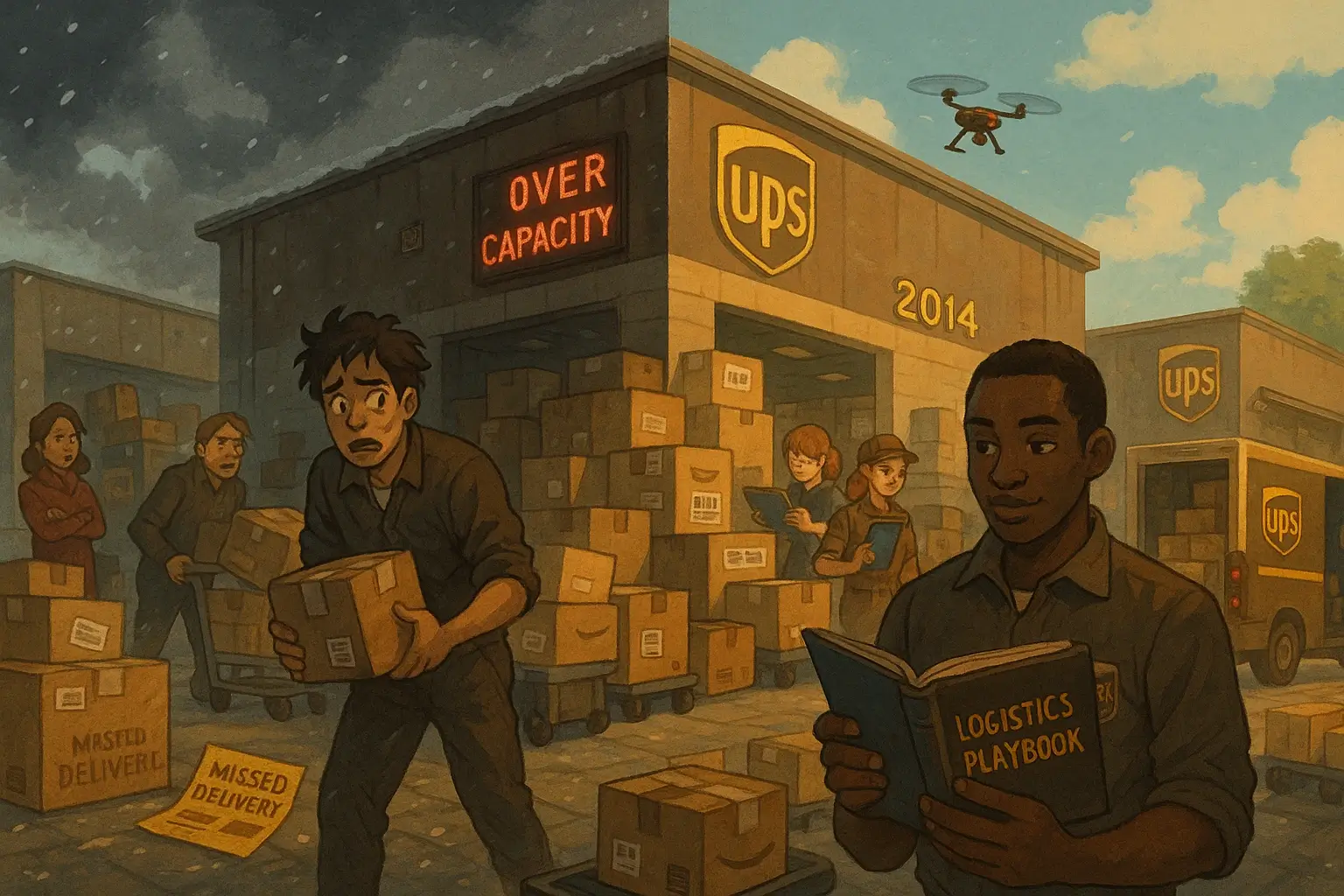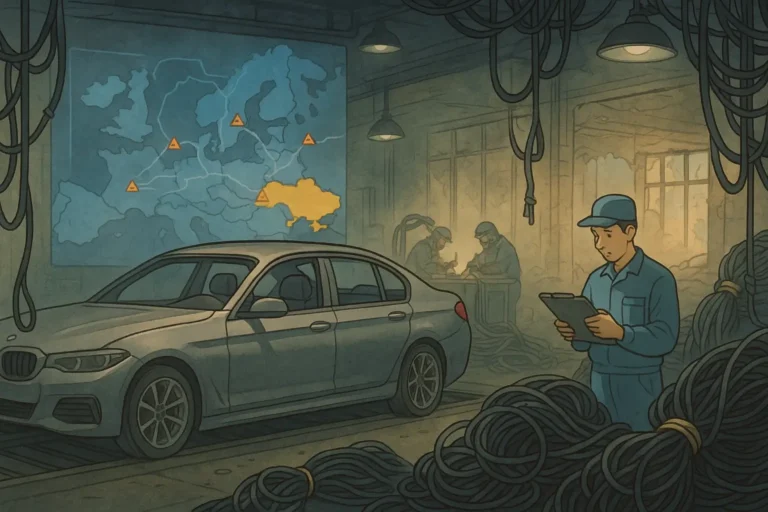
UPS logistics failure in 2013
The UPS logistics failure in 2013 and subsequent redemption in 2014 occurred due to poor demand planning. But what was the impact of the problem, and how did the company recover?
Article Brief & Key Nuggets:
- UPS failed to deliver millions of packages before Christmas in 2013 due to bad forecasting and overstretched air networks.
- In 2014, UPS overcorrected by spending over $500 million to avoid delays. It succeeded in delivery but lost profit due to low volume and high costs.
- By 2015, UPS found the right formula using pricing control, temporary sort centers, and tighter planning with retailers.
- Lessons include forecasting with clients, scaling flexibly, pricing to shape demand, and protecting brand trust.
- African logistics firms should avoid building for panic and instead plan for flexibility, data sharing, and customer communication.
Logistics Isn’t a Guessing Game. UPS Proved It the Hard Way
The 2013 UPS logistics failure did not occur because UPS lacked trucks or talent. It happened because the company gambled with demand and lost.
UPS underestimated holiday volumes, overtrusted its network, and watched millions of customers wake up to empty porches on Christmas morning. The next year, it threw money at the problem—$500 million in capacity.
Although it was able to handle the demand effectively, the fix came at a cost. UPS had guessed wrong again. Volumes came in lower than expected, and profits collapsed. UPS fixed delivery but broke its earnings.
This article breaks down how a logistics giant fumbled back-to-back holiday seasons—and why its 2015 comeback carries lessons for firms everywhere, especially in Africa’s rising e-commerce supply chain.
UPS Logistics Failure in 2013 and The Impact
UPS couldn’t match late e-commerce demand with fixed holiday delivery limits. Its air hubs ran out of aircraft, pilots, and sorting bandwidth right before Christmas.
“The volume of air packages in our system exceeded the capacity in our network,” UPS admitted publicly after the collapse.
Forecasts missed a critical shift, as online shoppers were placing orders even as late as December 23, expecting two-day guarantees because they had been promised. Retailers like Amazon had guaranteed customers that gifts would arrive in time.
However, delays in their own warehouses pushed late orders into UPS’s lap with no room left to recover. At the same time, winter storms froze up key routes, and with no extra planes or crews on standby, UPS cracked under pressure.
The impact:
- Congress called for full refunds.
- Customers flooded social media with frustration.
- Amazon issued $20 gift cards and shipping refunds.
- UPS became the face of the “holiday shipping crisis.”
- Approximately 1–2 million packages were missed for Christmas.
The reputational cost was bigger than the operational one. Brands that depend on trust don’t get second chances in December.
Read more: Learning From the Mondelez Trucking Crisis of 2018.
Why UPS Overcorrected in 2014 and Paid for It
Shaken by the 2013 failure, UPS moved aggressively to ensure that Christmas 2014 would be different. UPS’s CEO at the time, David Abney, and his team essentially vowed “never again.”
UPS responded to the 2013 logistics nightmare by doing everything and overdoing it. UPS poured an estimated $500 million into peak-season capacity upgrades, which included:
- Adding 6,000 trucks.
- Hiring 95,000 temps
- Fast-tracking new hubs
- Opened mobile sorting centers
For example, UPS built a new 400,000 sq. ft. sorting facility in Dallas/Fort Worth in under a year, operational by peak 2014 and increased its available aircraft and trailer capacity (adding hundreds of trailer staging positions at its Worldport air hub).
The company also changed operating rules, running full delivery service on Black Friday for the first time ever. It built a seasonal delivery army and never looked back—until the invoices came in.
UPS delivered 98% of express packages on time on December 24, 2014, a dramatic improvement from 83% on time in 2013. However, this success came at a significant cost.
UPS ended up with Q4 2014 profit down 61% from the prior year (only $453 million in earnings vs. $1.17 billion the year before). Analysts noted UPS “had more workers than package volume on some days during peak season.” But the financial results was disappointing.
- Volume forecasts fell short.
- Labor costs surged 20% in Q4.
- On-time delivery jumped to 98%.
- Customer satisfaction rebounded.
- Profit dropped 61% year-over-year.
Read more: Learning From Cisco’s $2.25 Billion Inventory Collapse and Write-Off in 2001.
How UPS Got It Right in 2015 and 2016
By the 2015 holiday peak, UPS aimed to combine the lessons of the prior two years to achieve both reliable service and controlled costs. The company implemented a more nuanced peak operations plan, often described by management as a “disciplined approach.”
Key elements of UPS’s 2015 peak strategy included:
- Enforcing order deadlines. Retailers couldn’t promise free two-day delivery on Dec. 23 anymore.
- Adding “surge pricing” for peak weeks. Late, high-volume shipments cost more.
- Deploying temporary sort centers selectively. Pop-up facilities supported high-volume areas only when forecasts required.
- Improving forecasting coordination. Retailers and carriers reviewed volume plans weekly and adjusted shipping timetables.
- Leveraging automation, not just labor. ORION route optimization, better sorting systems, and fewer manual touches cut operating drag.
The strategy worked. In 2015, UPS handled 612 million holiday packages, up 7% from 2014 and delivered most on time. Earnings bounced back. Confidence returned.
According to David Abney, the CEO of UPS, the company delivered the high-quality service that customers deserve and the financial discipline that shareholders expect.
Lessons From The UPS Logistics Failure in 2013 and The 2014 Failed Redemption
UPS is one of the world’s largest logistics companies. It’s logistics failure in 2013, a failed redemption in 2014, and ultimately getting it right in 2015 and 2016 holds valuable lessons for the logistics and shipping industry:
1. Guessing at Peak Demand Hurts Both Ways
If you underbuild, customers lose. If you overbuild, profits bleed. UPS lost in 2013 by ignoring demand signals. It also failed in 2014 by trying to please everyone without pricing limits.
Balance comes from flexibility, not forecasts.
You must scale up without locking in permanent cost. That means hiring seasonal labor only when needed. It also means using temporary facilities, rental fleets, and demand thresholds to guide action. Build to flex, not to impress.
2. Peak Season Logistics Requires Shared Forecasting
Retailers cannot plan marketing alone. Carriers must be in the room when big promotions or cutoff guarantees are made. UPS learned this in 2014 when it held joint planning meetings with clients. By 2015, forecasting was a team sport.
Ask your client: How much volume will you push? When? What mix of service types? It is vital to build scenarios, not work with guesses. Sharing information with partners is no longer a privilege but a necessity.
3. Temporary Sort Centers Can Bridge Surges
UPS’s mobile hubs were not vanity builds—they were built in weeks, moved by rail, and scaled down after use. They gave UPS the power to absorb spikes without burning capital on year-round fixed sites.
Companies can learn from this by leasing space near demand clusters in Q4. Think warehouse tents, school parking lots, or mobile containers. Add value without adding a burden.
4. Pricing Should Guide Behavior, Not Just Profit
“We’re not trying to punish demand—we’re trying to pace it,” one UPS planner explained.
UPS didn’t just raise rates. It used targeted surcharges to reshape behavior. Last-minute bulk orders became more expensive. That nudged retailers to order earlier or smoothly.
Think of it like surge pricing in logistics: it tells customers when not to overload you. Create pricing tiers for standard, fast, and ultra-fast shipping. Add peak penalties during end-of-year weeks. Reward early volume.
5. Customer Experience Can’t Be Traded for Margin
UPS lost customer trust in 2013. It regained it in 2014, but at a financial cost. It finally kept both in 2015 because it saw brand trust as infrastructure. Don’t wait for damage to fix what should’ve been protected.
One delivery failure during a major event can burn years of brand building. It’s not just parcels on trucks. It’s people trusting you to deliver promises.
Read more: How DHL’s Warehouse Robotics Transformed Its Warehousing and Fulfilment.
How African Logistics Companies Can Apply These Lessons
Africa’s supply chain is hitting its own digital tipping point. With Black Friday, festive rushes, and mobile-first shoppers, peak season logistics is no longer seasonal—it’s strategic.
Here’s how to get it right:
- Start forecasting with clients on time. Ask them to project sales events, promos, and shipment estimates early.
- Use flexible hubs. Partner with event centers, sports arenas, or school yards to set up mobile sort centers.
- Set limits. Don’t accept every last-minute order if you can’t guarantee it. Limit express promises close to holiday deadlines.
- Use peak pricing. Create “premium days” where delivery is more expensive. This shapes when customers order.
- Overcommunicate. Update clients and end-customers about cutoff dates, delays, and plan adjustments.
Don’t repeat UPS’s 2013 mistake. Don’t overcompensate like it did in 2014 either. Instead, learn from how it won in 2015—with discipline, design, and data.
The Bottom Line
The UPS logistics failure in 2013 didn’t start with trucks or planes. It began with flawed assumptions and no safeguards. Winning in peak season doesn’t mean throwing more people and vehicles at the problem.
It means building smart, planning early, and protecting both service and cost. African logistics firms don’t need to fail first to learn this. They can apply the lessons now and win before the storm hits.

Obinabo Tochukwu Tabansi is a supply chain digital writer (Content writer & Ghostwriter) helping professionals and business owners across Africa learn from real-world supply chain wins and setbacks and apply proven strategies to their own operations. He also crafts social content for logistics and supply chain companies, turning their solutions and insights into engaging posts that drive visibility and trust.





